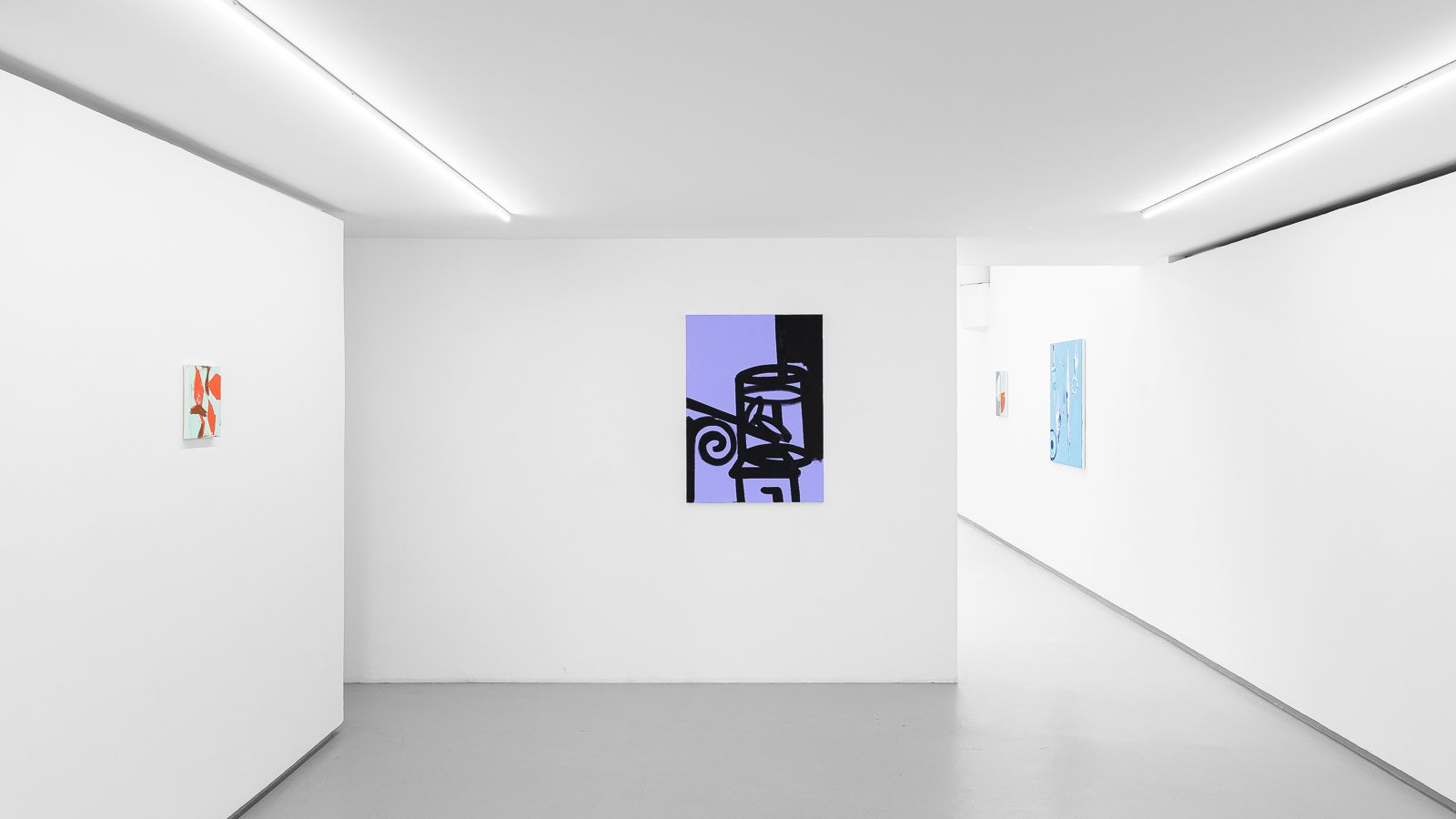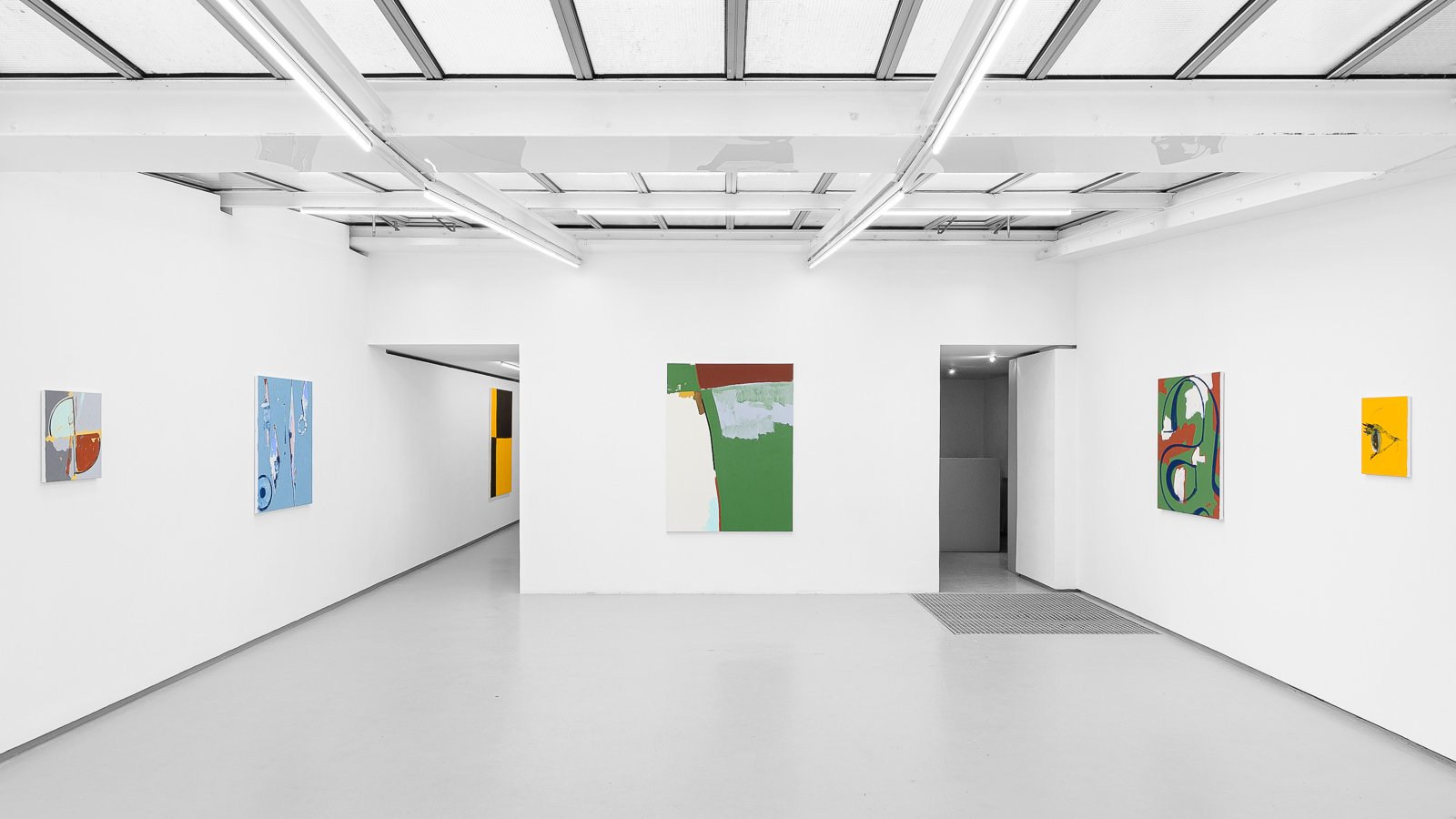Hugo Pernet peint dans l’atelier, au temps des écrans. Son « profil » Instagram dessinerait un portrait par vignettes tels des échantillons. Est-ce que les images de peintures sont encore des peintures ? Ou encore, est-ce que la peinture peut se réduire à des stimuli visuels ? Le temps d’attention d’Instagram, le cropping, la photogénie convoquent des manières de regarder instantanées. Le doigt glisse sur la surface, la pression de la pulpe de la phalange fait défiler les images, vite : « scroll ». On parle de navigation sur les pages des sites, celle-ci se fait de manière verticale, jusqu’à une ligne de « bas de page » qu’on appelle « ligne de flottaison ». La ligne de flottaison est ce qui sépare les parties immergées et émergées d’un bateau. On dit « œuvres vives » pour ce qui se trouve sous les flots et « œuvres mortes » pour ce qui est au-dessus. Sous l’eau, c’est le domaine du poisson rouge, dont la mémoire serait de trois minutes, selon la croyance populaire.
Que se passe-t-il sous cette ligne imaginaire ? On peut retracer les cheminements et degrés d’attention, de profondeur sous la surface, grâce au « scrollmap » et « heatmap » qui déterminent les cheminements, durées de recherche. Peut-on parler d’épaisseur de la surface ? Au-delà de l’oxymore, il y a une réalité du temps d’attention sur les écrans qui relève d’une mémoire captive. Ce temps d’attention est capté, capitalisé et utilisé par des algorithmes pour nous redonner « du même » en boucle, une forme d’autophagie scopique.
Qu’est-ce que la mémoire sinon l’activation volontaire ou involontaire de souvenirs ? From Memory, 2022 et From Memory 2, 2022 induisent une mémoire des formes comme une mémoire de l’eau, comme si tous les poissons rouges après Matisse ne pouvaient exister « sans référence ». Comment savoir si ceux-ci sont réels ou préenregistrés ? Le terme « scroll », qu’on prend pour un anglicisme, vient du Français « escroquer ».
« Le tableau est un trompe l’œil d’image, un leurre » dit Hugo Pernet. L’artiste parle de sa mauvaise foi et des malentendus en art. On lui reproche un éclectisme stylistique. De quel style parle-t-on ? La répétition du même motif, la marque de reconnaissance facile qui rejoint le marketing ou le rassurant lieu commun ? Hugo Pernet ne cherche pas à être « un » goût. L’escroquerie de la peinture au temps des images en flux tendu, c’est introduire un « bug », une brèche dans le système, une prise de conscience du poisson dans son bocal.
Mais qui est le poisson ? Cela pose la question du regardeur et du regardé, en clin d’œil à Duchamp. A chaque fois, le contenu, le contenant et le système qui les contient sont structurés comme une poupée russe. Hugo Pernet fait de la fausse monnaie qui se présente comme telle. C’est du fishing qui attrape les poissons que nous sommes, toujours friands d’appâts. Des poissons conscients d’évoluer dans un bocal, petit théâtre de la mémoire que devient la galerie.
Le « déjà-vu » et la reconnaissance par similitude fonctionnent par analogie. Le cerveau établit des liens entre des fragments d’informations qui vont « faire image ». Dans Never Learn (2022) une grande figure bleu cyan composée de linéaments turquoise sème le trouble sur ce qui est dessus et ce qui est dessous. Le recouvrement bleu sombre autour du dessin central crée du jeu, un « contre-ciel » en volutes. Il s’agit d’un « drapé en lévitation » comme l’indique l’artiste. Dessin trouvé sur un livre de leçons d’arts martiaux chinois illustré, il devient un espace filaire. La peinture est aussi un sport de combat, dans lequel on apprend très vite à chuter et à se relever. Éternels apprentis toujours débutants, il s’agit de mobiliser notre défiance face au savoir. L’aplat sombre opacifie l’espace et donne au coin non recouvert une valeur d’indice. Nous sommes sur le point de bascule du plan, entre horizontalité du sol sur lequel l’artiste besogne en partie et verticalité du mur où le travail du regard commence, au point tournant entre deux plans (Pinwheel, 2022).
Folded circle, 2022 contient la forme d’une hélice dont les pales tournent autour d’un axe. Lorsqu’on plie un disque en le vrillant par son centre, on obtient une forme de huit. C’est le signe de l’infini, une boucle qui tourne sur elle-même. C’est aussi une croix, un x horizontal, un poisson rouge.
Marie de Brugerolle
Hugo Pernet paints in the studio, in the time of screens. His Instagram "profile" would draw a portrait by thumbnails like samples. Are images of paintings still paintings? Or can painting be reduced to visual stimuli? Instagram's attention span, cropping, photogenics summon instant ways of looking. The finger glides over the surface, the pressure on the pad of the phalanx moving up and down the images, quickly: "scroll". We talk about navigation on the pages of the sites, these are done in a vertical way, until a line of "bottom of page" which we call "waterline". The waterline is what separates the submerged and emerged parts of a boat. We say "live works" for what is under the water and "dead works" for what is above. Underwater is the domain of the goldfish, whose memory is believed to be three minutes long.
What happens below this imaginary line? We can trace the paths and degrees of attention, of depth under the surface, thanks to the "scroll map" and "heatmap" which determine the paths, the search times. Can we talk about the deepness of the surface? Beyond the oxymoron, there is a reality of attention time on the screens which is a captive memory. This time of attention is captured, capitalized, and used by algorithms to give us back "the same" in a loop, a form of scopic autophagy.
What is memory but the voluntary or involuntary activation of stored recalls? From Memory, 2022 and From Memory 2, 2022 induce a memory of forms like a memory of water, as if all goldfishes after Matisse could not exist "without reference". How to know if these are real or pre-recorded? The term "scroll", which we take for an anglicism, comes from the French "escroquer" which means "defraud", to sell a "fake" for granted.
"The painting is a trompe l'oeil of image, a decoy" says Hugo Pernet. The artist talks about his bad faith and misunderstandings in art. He is reproached for his stylistic eclecticism. What style are we talking about? The repetition of the same motif, the easy mark of recognition which joins the marketing or the reassuring commonplace? Hugo Pernet does not seek to be "a" taste. The swindle of painting in the time of the images in tense flow, it is to introduce a "bug", a breach in the system, an awareness of the fish in its jar.
But who is the fish? This raises the question of the viewer and the viewed, in a nod to Duchamp. Each time, the content, the container, and the system that contains them are structured like a Russian doll. Hugo Pernet makes counterfeit money that presents itself as such. It is fishing that catches the fish that we are, always fond of bait. Fish conscious of evolving in a bowl, a small theater of memory that becomes the gallery.
The "déjà-vu" and the recognition by similarity work by analogy. The brain establishes links between fragments of information that will "make an image". In Never Learn (2022) a large cyan blue figure composed of turquoise lineaments confuses what is above and what is below. The dark blue overlay around the central drawing creates play, a "counter-sky" in volutes. It is a "levitating drape" as the artist calls it. Drawing found on a book of lessons of Chinese martial arts illustrated, it becomes a wire space. Painting is also a combat sport, in which one learns very quickly to fall and to get up again. Eternal apprentices, always beginners, it is a question of mobilizing our defiance towards knowledge. The dark solid opacifies the space and gives the uncovered corner a value of index. We are on the tipping point of the plane, between the horizontality of the ground on which the artist works in part and the verticality of the wall where the work of the glance begins, at the turning point between two planes (Pinwheel, 2022).
Folded circle, 2022 contains the shape of a propeller whose blades turn around an axis. When a disk is folded by twisting it through its center, a figure of eight is obtained. It is the sign of infinity, a loop that turns on itself. It is also a cross, a horizontal x, a goldfish.
Marie de Brugerolle

















